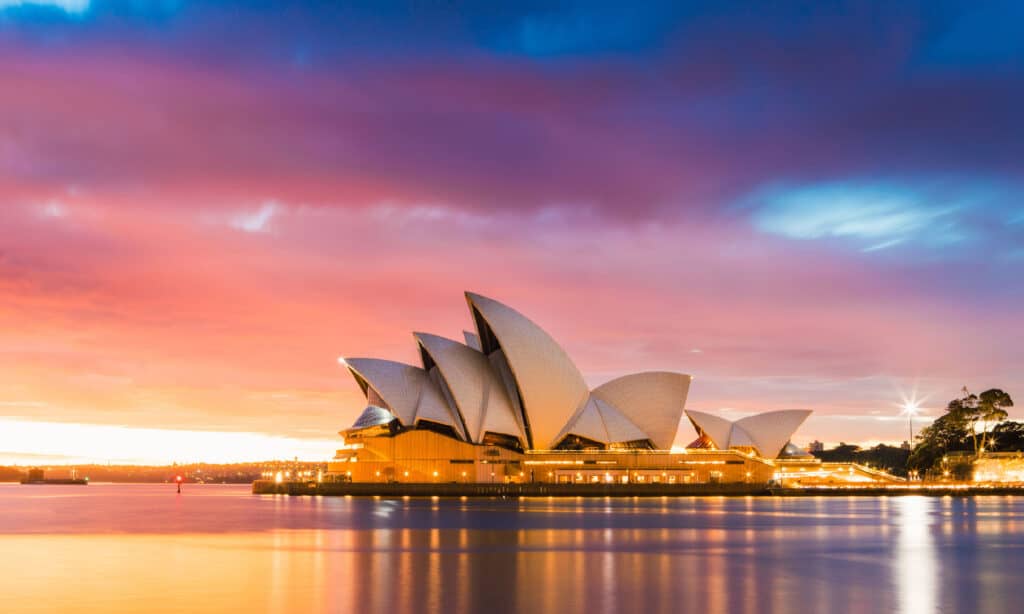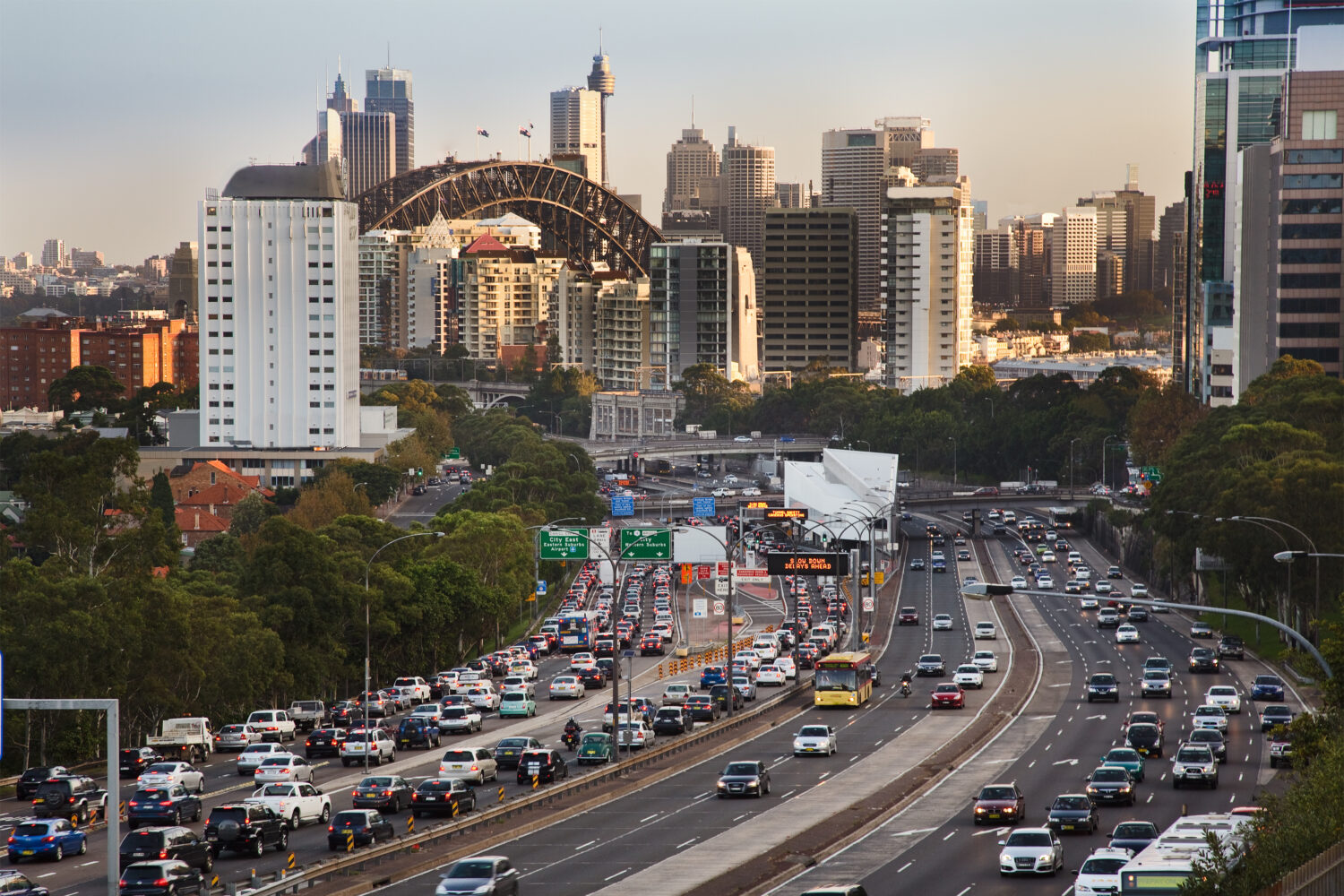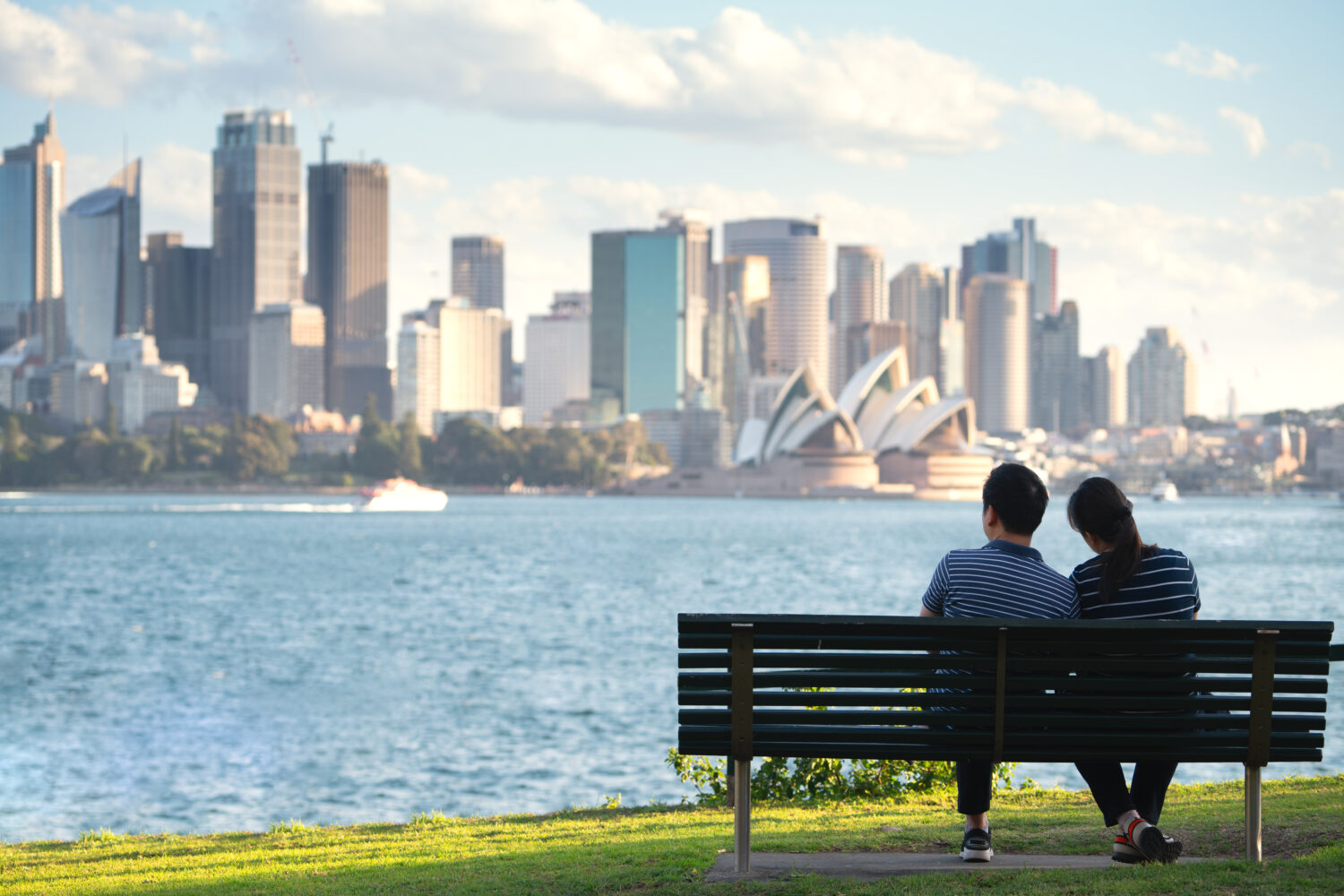The Largest City in New South Wales Now And In 2050
Sydney, the current and future biggest and capital city of New South Wales (NSW), teems with life at every corner. The Sydney Opera House and the grand Sydney Harbour Bridge are iconic. Sydney’s golden beaches and busy harbor speak to its dual identity: a laid-back beach town wrapped in a sophisticated urban shell.
For a city as sprawling and ever-growing as Sydney, continual urbanization is a double-edged sword. Not only is Sydney the most populous city of NSW, but it also tops the ranks of cities nationwide. While expansion has turbocharged the economy and added a multicultural richness, it’s also nudged the city into a slew of new challenges. Think escalating home prices, mounting traffic woes, and an ever-increasing pressure on its infrastructure. In essence, metropolitan growing pains. Yet, Sydney has responded with innovation and mindful planning, as well as an array of initiatives aimed at sustaining its growth while preserving its unique character. Here, we explore what those plans are, and what the Sydney of 2050 might look like.

©iStock.com/ai_yoshi
The Sydney of Today
Leading Industry Sectors
Sydney is Australia’s economic powerhouse. It contributes a significant chunk to the nation’s GDP and about 45 percent of the entire country’s financial services output. Likewise, Sydney’s technological innovations, especially in the realm of digital and information communication technology, have put it on the map as a burgeoning Silicon Valley of the Southern Hemisphere.
Beyond its traditional strengths, Sydney is venturing into new terrains. Whether it’s the rush to renewable energy or the rise of a robust healthcare tech scene, the city is poised at the vanguard of industries that matter most for the future. Though not explicitly charted (what industry-disrupting startups are?), these emerging sectors are growing rapidly. They reflect Sydney’s adaptability and its willingness to pivot towards more sustainable and technologically advanced industries.
The Cultural Landscape
The aromas of Lebanese shawarma float into a Vietnamese market. Down the road, worshippers pile out from an Orthodox Serbian church. Neighborhoods like Cabramatta and Leichhardt are microcosms of the global influences that make Sydney a truly modern city.
Head to the city core and meander to the highbrow art exhibitions at the Art Gallery of NSW. Then head to the indie bands that perform in the tucked-away corners of Newtown. Amble a bit further for cultural acknowledgments of the aboriginal Gadigal People whose ancestral home Sydney stands upon. Again, the city shows its depth and breadth of culture. Interested in SXSW Down Under? There’s the annual Vivid Sydney festival. This amalgam of light, music, and ideas, not only draws artists and thinkers from around the world but also captivates the city’s own diverse populace.
Sydney’s Population Dynamics
Home to over 5 million residents as of 2023, Sydney has a population density of 2,037 individuals per square kilometer. This makes it as a significant urban entity, albeit less densely packed compared to cities like New York or Tokyo. However, its most densely packed area, Haymarket, at 19,500 people per square kilometer, is nothing to sneeze at.
Quality of Life in Sydney
High Quality at High PricesIn Sydney, the high quality of life can also come at a high cost. Housing, often the largest expenditure for many, is a double-edged sword here. While the city has a strong economy and competitive international salaries, the cost of housing is prohibitive to most. According to the Demographia International Housing Affordability report, Sydney is the second least affordable housing market globally, eclipsed only by Hong Kong. Less than 1 percent of the country’s rental units are currently available. This lack of available rentals has brough rent prices to unprecedented heights. Further, it has intensified an already burgeoning cost-of-living crisis that has propelled a significant increase in homelessness, up by a whopping 23 percent this year when compared to 2022 numbers.

©Taras Vyshnya/Shutterstock.com
The city’s transportation system is largely commendable for its efficiency and quality, though Sydney’s traffic congestion, while already the worst nationwide, has only been getting worse. Sydney stands tall in education, ensuring access and quality across primary, secondary, and vocational training platforms. In fact, the University of Sydney ranks 60th globally in the Times Higher Education rankings. Additionally, Sydney is a notably safe city, which is a key factor in attracting new residents in general and global talent in particular.
Great Culture and BalanceIts commitment to environmental stewardship, bounty of theaters, museums, and sporting arenas, also make it a great place to live. Further, its focus on inclusivity is an especially important aspect of quality of life for immigrants to the city.
Sydneysiders, as they call themselves, typically strike a balance between work and leisure, with reasonable working hours and provision for breaks. Residents harbor high trust in their government and politically stable environment. The robust healthcare that fuses accessibility with pioneering medical research is also a point of pride. So it’s unsurprising that 81 percent of Sydneysiders are satisfied with their quality of life in the city. By comparison, cities like New York and London score 75 and 76 percent respectively.
Yet, like any major global city, Sydney grapples with economic disparities. This is particularly stark in the housing sector, as noted above. Additionally, worsening traffic congestion is likely to eat into the work-life balance so many Sydneysiders pride themselves on. Fortunately, these are all human problems that, with enough grit, will, and resources, can be headed off and dealt with by human hands, heads, and hearts.

©Jason L, CC BY-SA 4.0, via Wikimedia Commons – License
Sydney in 2050: A Vision for the Future
As Sydney’s urban identity morphs, so too its demographics. Projections suggest a population range of around 6.1 to 8.48 million by 2050, a notable rise of up to 60 percent from the current 5.3 million. This demographic upsurge will strain housing and infrastructure, as well as precious resources like drinking water.
On the flip side, a larger, diversified workforce can inject energy into Sydney’s economy. Moreover, smart management of population density could foster more sustainable, walkable communities. This classic tango of necessity and invention aligns with Sydney’s environmental aspirations.
Sustainability Goals and Planning
Sydney is a city with its eyes on the future, setting an ambitious target to reach net-zero emissions by 2035. As part of its Sustainable Sydney 2030–2050 Continuing the Vision, the goal underscores the city’s commitment to environmental stewardship. Setting aside the lack of a snappy name for the plan, the vision encompasses holistic environmental pathways that thread energy, water, and waste management into a coherent strategy.

©anek.soowannaphoom/Shutterstock.com
Sydney’s Future Infrastructure Projects
Public Transport EnhancementsStaying ahead of its booming population, Sydney is revamping its public transport system. $72.3 billion AUD has been earmarked for infrastructure for NSW. Roughly $30 billion is tagged solely for public transport projects like the new rail and metro lines, as Sydney prepares to double in population in the next two decades.
Proposed Parks and Conservation AreasBuilding on its earlier “Greening Sydney 2012” strategy, which ambitiously aimed to plant 700 new street trees per year and cover 40 percent of the city in greenery by 2050, the updated “Greening Sydney Strategy” of 2021 (based on its most recent modified July 2023 version) brings a renewed focus. Not only does it aspire to mitigate the insidious urban heat island effect, but it also emphasizes a holistic approach that integrates social, environmental, and cultural considerations. Think not just green roofs, walls, and streets, but also community participation, biodiversity, and Indigenous ecological practices. The strategy envisions a city that’s cool, calm, and resilient, offering both a sanctuary and a sustainable way of life to its inhabitants.
Local Food Production InitiativesAlong the lines of places like Detroit, Chicago, and Vancouver, urban agriculture in Sydney is an integral part of the city’s larger greening strategy. In line with the focus on community health and well-being, the city is putting a concerted effort into localizing food production. This initiative aims to reduce food travel distances, thereby minimizing carbon emissions, and foster community well-being.
Projected Demographic Changes in Sydney and NSW
Sydney is poised for substantial growth, expecting a 60 percent surge in population by 2050. This influx will bring diverse age groups and cultural backgrounds, requiring adaptive urban planning and community services.
Age and Population TrendsThe aging population will call for accessible urban designs. Indeed, Australia expects its population aged over 85 to double in the next quarter century. Meanwhile, younger residents will drive demand for innovative job markets and educational opportunities.
Immigration and Cultural DiversitySydney’s cultural fabric will further diversify due to global migration. In response, the city has initiated programs like A City for All as part of its sustainable social policy. Additionally, in recognition that nearly half of the city’s population is foreign-born, Sydney set up the Multicultural Community Advisory Committee to help foster social cohesion.

©Budimir Jevtic/Shutterstock.com
New South Wales: A Comprehensive Look at Demographic and Political Influences
To fully grasp Sydney’s future, a broader perspective on the demographic and political landscape of New South Wales (NSW) is essential. This wider view offers valuable insights that directly impact Sydney’s urban planning and policies.
Demographic Shifts in NSW
NSW’s population grew from 7.5 million in 2016 to 8.1 million in 2021, with two-thirds residing in Greater Sydney. Overseas-born residents make up 29.3 percent of the state’s population. Importantly, population changes in NSW are driven by a combination of factors: births, deaths, overseas migration, and domestic migration. Projections are formulated based on assumptions about these elements, including age profiles that help set migration assumptions.
Age and Lifestyle Evolution
The median age in NSW has risen to 39, signaling an aging population. Housing trends reveal a decline in homeownership, supplanted by diverse dwelling options and smaller households. Life expectancy has been increasing in Australia, contributing to population growth but also leading to more deaths among older age groups.
Linguistic and Religious Changes
While English remains the dominant language, linguistic diversity is on the rise. Arabic, Mandarin, Cantonese, and Hindi, all make up significant minority languages. Religious affiliations are also shifting, with a decline in Christianity and an uptick in non-affiliation and other faiths.
Influence of Migration on Population
Migration, both from overseas and within Australia, plays a pivotal role in shaping NSW’s population. As with many countries, the COVID-19 pandemic has disrupted overseas migration, creating long-term implications due to changes in the age profile of incoming and outgoing populations. Domestic migration, too, has a significant impact, especially as migration corridors within Australia remain consistent over time.
Births and Deaths: The Natural Factors in a Shifting Landscape
Every birth significantly contributes to NSW’s population growth, and projections consider both the average number of babies born and the number of women of parenting age. On the other side of the equation, deaths naturally slow down population growth, a trend affected by rising life expectancy.
Maternal Age and Childbirth Methods
Recent data reported in The Sydney Morning Herald reveals noteworthy trends in maternal age and childbirth methods:
Rising Age of First-time MothersThe average age of first-time mothers in NSW has increased from 30.7 years in 2017 to 31.3 years in 2021.
Lowest Birth Rates in Over a DecadeThe number of babies born in NSW public hospitals in the first quarter of 2023 is the lowest in over a decade. Factors such as COVID-19 lockdown conceptions, financial pressures, and climate anxieties contribute to this decline.
Long-Term ConcernsThis decline is influenced by both short-term factors related to the pandemic and longer-term concerns like housing and climate change, leading more couples to have fewer children than they would like.
Historical ContextThe fluctuation in birth rates echoes a temporary phenomenon observed in Australia post-World War II. However, the overall fertility rate has been declining since the 1970s, except for a brief upswing in 2002 due to the baby bonus.
Fertility Rates Across AustraliaIn 2021, Australia’s total fertility rate increased to 1.7 births per woman, albeit still below the replacement level. The rates vary across states, with the Northern Territory having the highest and the Australian Capital Territory the lowest.
These shifting trends in childbirth and maternal age are expected to have complex socio-economic implications for society in the long term. Natural factors like births and deaths have a significant impact on NSW’s population. Yet they are themselves subject to a range of influences. Within the context of global pandemics and climate change, these include personal choices and healthcare access, as well as broader societal and economic pressures.
Implications for Sydney
Sydney’s urban planning and policies are profoundly influenced by these demographic shifts in NSW. This includes the need for accessible infrastructure and culturally inclusive community services. Factors like migration, both overseas and domestic, births, and improving life expectancy, interplay to shape the demographic dynamics not just of NSW but also of Sydney.

©Rawpixel.com/Shutterstock.com
Political Context: A New Era in NSW Politics
The 2023 NSW state election marked a pivotal moment, with Chris Minns’ Labor Party defeating Dominic Perrottet’s long-standing Liberal/National Coalition. Minns’ premiership ended a 12-year Coalition reign, inaugurating the state’s first Labor government in over a decade.
National Impact
This change mirrors broader shifts in the broader politics of Australian. With Labor now in power across Mainland Australia, it suggests that voter preferences are evolving. This is possibly in response to national or statewide challenges, of which there are many.
The Intersection of Demographics and Politics
NSW’s changing demographics, especially its diversifying and aging population, may both influence and be influenced by these political shifts. This interplay offers a nuanced perspective for understanding policy priorities in Sydney and across NSW.
Factors Influencing Migration to Sydney: Balancing Economics and Sociopolitics
Understanding migration patterns in Sydney requires a multifaceted examination. This includes the economic incentives and sociopolitical factors. They all add layers of complexity to the city’s population dynamics.
It’s About the Jobs
Sydney’s robust job market across various sectors serves as a significant magnet for migrants. However, this attraction is counterbalanced by high living and housing costs, causing some to reconsider Sydney as their destination.
While job availability is a key driver, other economic factors like wage levels and overall economic stability also influence migration decisions. The broader state and national economic climate can either enhance Sydney’s appeal or make it less attractive.
Sociopolitical Factors
Sydney’s cultural diversity and quality of life, buttressed by its access to education, healthcare, and other services, add another dimension into the calculus of potential migrants.

©iStock.com/master2
Navigating the Climate Challenge: Sydney’s Multifaceted Approach to Environmental Resilience
In Sydney, the looming specter of climate change has spurred a comprehensive effort from government agencies and communities alike to fortify the city’s environmental resilience. Sydney’s approach is holistic, focusing on sustainable water management, climate adaptation, and future-proofing essential resources.
Sustaining Sydney: An All-Encompassing Strategy
Sydney’s environmental policies are wide-ranging, covering water conservation, waste reduction, energy efficiency, and sustainable transportation. These strategies collectively serve as Sydney’s framework for combating environmental challenges and fostering a sustainable future.
Sustainable Water Management
Sydney has rolled out a series of dynamic water strategies to safeguard its future. Leading the efforts is Sydney Water’s Sustainable Urban Water Management initiative, which brings together stakeholders from across Greater Sydney to promote responsible water use. Sydney has also tapped into the promise of recycling, supplementing traditional water sources with reclaimed industrial and household water. On the streets and in homes, there’s a growing emphasis on water-wise habits, where residents are encouraged to swap their water hoses for brooms. A staggering 85 percent of the city’s water supply relies on rain, which grows less reliable with climate change. drought preparedness isn’t just a buzzword—it’s a commitment.
For the corporate realm, the WaterFix Commercial program is Sydney’s comprehensive plan for the private sector. In essence, Sydney’s water strategies offer a blend of innovative solutions and age-old wisdom that shoots for a balanced approach to sustainable water practices.
[spacer]
In a world increasingly defined by climate crises and social inequities, Sydney chooses not to be a bystander. The city’s ambitious roadmap for sustainability works in tandem with sweeping measures aimed at fostering community cohesion and inclusivity. From its multipronged approach to water conservation to green urban planning, Sydney offers a textbook case in how to create a resilient, equitable future. In essence, Sydney may just be setting the gold standard for what global cities could— nay, should—strive to become.
Conclusion
With the world population set to peak at around 10.4 billion by century’s end, we are clearly entering a new era of urbanization. Cities like Sydney offer a compelling vision of what is possible. As the city down under evolves with intentionality, it keeps a keen eye on the triple bottom line of economic, environmental, and social sustainability. In parsing Sydney’s current realities and future aspirations, we gain not just an intimate understanding of this Australian metropolis but also a nuanced blueprint for navigating the complexities of 21st century urban life. Through its balanced and enlightened approach, Sydney paves the way for cities everywhere to transition from mere hubs of human activity to abiding beacons of sustainable, inclusive civilization.
Summary Tables
Sydney’s Projected Population Growth by 2050
| Scenario | Population Estimate (Million) |
|---|---|
| Lower Estimate | 6.36 |
| Middle Range | 7.42 |
| Upper Limit | 8.48 |
Climate Challenges and Adaptation Measures
| Climate Challenges | Adaptation Measures |
|---|---|
| Sea-Level Rise | Coastal Defense Systems and New Stormwater Pipe |
| Bushfires | Early Warning Systems |
| Temperature Rise | Urban Greening |
| Drinking Water Scarcity | Comprehensive Public and Private Efforts |









